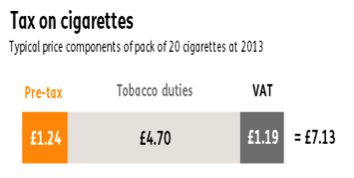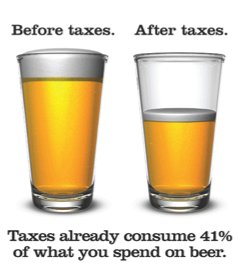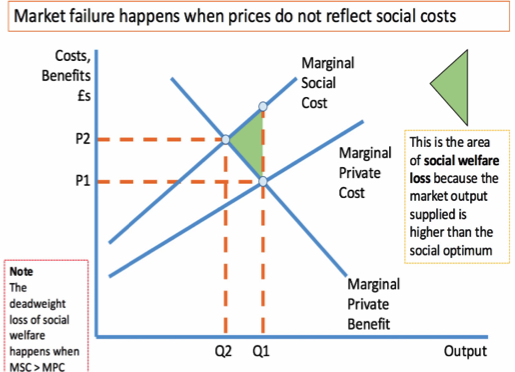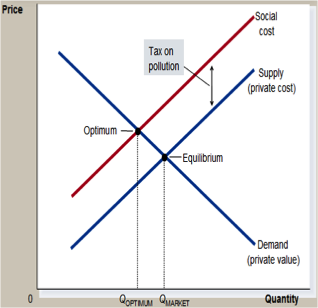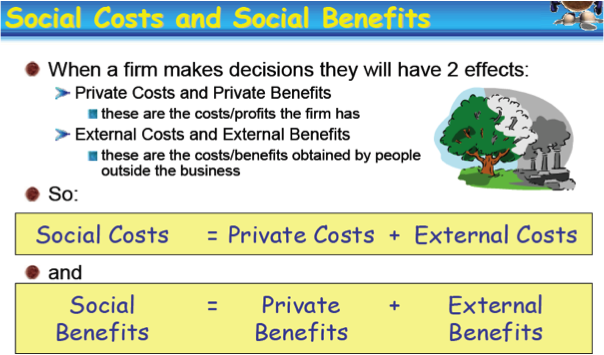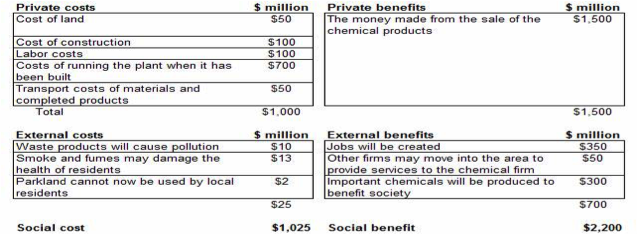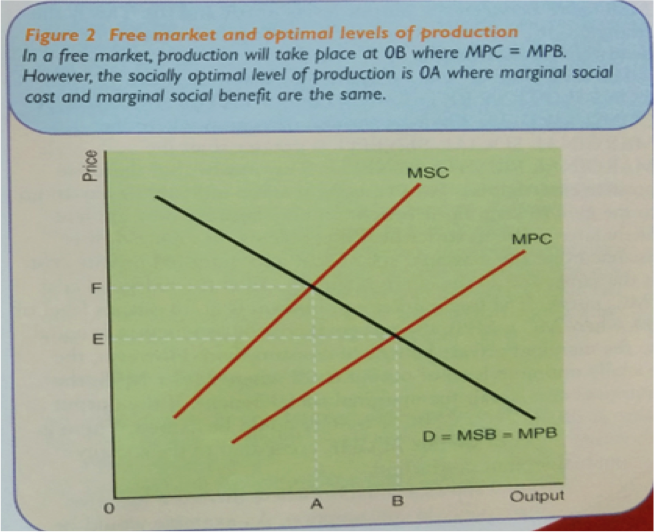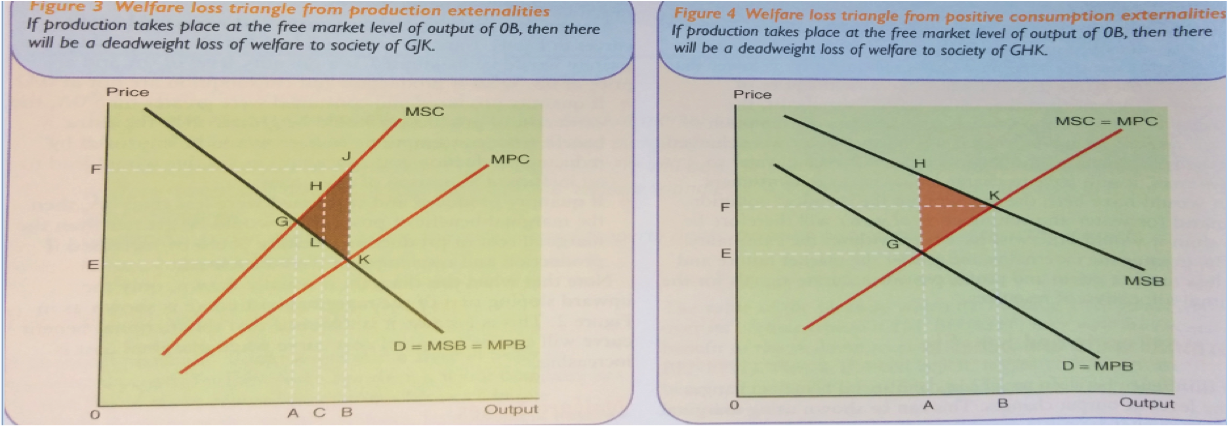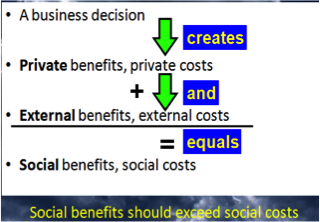Externalities
Internalising the external costs / polluter pays principle
When there are negative externalities, there is an external cost paid by third parties. However it might be hard to quantify, as are the external benefits. The overall impact maybe valued in different ways by different people. Sometimes, whether or not an externality is acceptable will be a political decision (e.g. nuclear energy).
Private sector businesses don’t care about external costs and might only care about external benefits purely for CSR marketing reasons. Manufacturers are only interested in maximising profits – pollution is seen as part of the package, an acceptable negative externality. Is it right that prices only reflect the private/internal cost to the business? Surely they should reflect the external cost to society as well?
This would require government intervention on demerit goods (overall negative impact on society) via indirect taxation, thus internalising the external cost (aka the polluter pays principle). Excise duty/sin taxes are classic examples of this. Aviation tax, landfill tax, cigarette duty, alcohol duty are all there to try to eliminate the over-production/consumption of these demerit goods and thus bring supply to the socially optimum equilibrium level.
Impact of prices not reflecting social costs
The costs that a supplier will consider - the private costs - determine supply. Therefore, the PC curve is the basis for the supply curve. Similarly, the PB curve determines the demand curve. Neither the consumer nor supplier considers the external benefits/costs. In theory, the equilibrium point should be at the point where the social benefits and social costs cross. In reality, there are either positive or negative externalities and an external benefit which if foregone or an external cost which is suffered (you should know the diagrams by now).
Quite simply, a free market will under-produce where there are external benefits and over-produce where there are external costs.
Sometimes external costs/benefits can be clearly identified and are quite easy to value, making ‘internalising the external cost’ easy. E.g. congestion charges in London. However subjective valuations and information gaps can make valuing some externalities dependent on guesstimates or simply impossible. E.g. Obesity, how do you implement the ‘polluter pays’ principle with a fair ‘fat tax’?
Environmental Externalities
Outlining the environmental negative externalities that exist in the modern day such as: factory discharge, traffic jam, climate change, pollution, dumping of waste, non-recyclable waste, noise pollution etc.
In 2006, the Stern Review of climate change for the UK gov said that “the evidence gathered by the review leads to a simple conclusion; the benefits of strong and early action far outweigh the economic costs of not acting”. Although it is estimated that if we are truly environmentally responsible and act towaRds climate change, the economic cost (e.g. of using more expensive renewable energy than fossil fuels) is 1% of GDP per annum.
Can the current gov afford for our economy to contract 1% p.a.?
Looking at the specific consequences of climate change, there are serious and growing problems:
-
Global sea level has risen by about 19cm since reliable record keeping started in 1880. This is the result of added water from melting ice caps and the expansion of seawater as it warms.
-
Global warming and the ‘hockey stick curve’ – July 2016 was the hottest month on record! The incidence of extreme weather events such as flooding and droughts is projected to increase.
-
In ‘heating trapping gas emissions’ (aka the greenhouse effect) continues to grow, increases of a month or more in the lengths of the frost-free and growing seasons are possible in some regions (have you noticed the seasons in the UK being more mild and projected than normal?), whilst other regions will become less fertile and desertification is likely to increase.
These problems affect different regions in different ways:
-
The Maldives (low lying islands in the Indian Ocean) is searching for new homes for their people.
-
Densely populated low-lying areas of Bangladesh are expected to flood more frequently, with land areas shrinking.
-
In 2016, Ethiopia suffered its worst drought in 50 years, with 90% of crops in some areas ruined and at least one million cattle have died.
-
MEDCs are not immune – California and most of Australia have serious drought problems. There has been an increase in flooding and water shortages in parts of Europe.
Attempting to value the costs would be difficult, as would apportioning responsibility. It is widely accepted though that greenhouse gases such as CO2 are the main cause and that many emissions result from the use of fossil fuels such as coal, oil and gas.
Rapid economic development in China has resulted in pollution and persistent smog in industrialised areas. The World Bank has reported thousands of premature deaths and incidents of respiratory illness. There has been a serious trade-off of China’s rapid economic growth – their environment.
The awareness of such issues has grown in China, there were some reductions in emissions in 2016. However with the cost to GDP of truly tackling their environmental issues, couple with their economy currently cooling down and some worrying that the bubble might pop, although China are vastly developing their solar cell technology they won’t be shifting from their dependency on coal anytime soon.
Underproduction or underconsumption
When less is produced than would be optimal for society as a whole, given the external benefits of the product. E.g. Gym memberships.
If quantity produced/consumed is greater than OA (i.e. figure 2 below), the extra cost of production is greater than the extra benefit of production (MSC > MSB – negative ext). Welfare would be improved via reducing production and consumption back to OA – therefore there is an inefficient allocation of resources (market fail) and a welfare loss.
If quantity produced/consumed is less than OA, then the MSB > MSC. Welfare could be optimised if production and consumption were increased
If production and consumption takes places at OB (which it will, for, in theory, firms will always want to supply to the market at the quantity when M__P__B cover M__P__C) then there is a welfare loss to society. The loss is the difference between the MSC and the MPB shown in Figure 3 below.
On the ‘OBth’ unit, this is JK. On the ‘OCth’ unit, this is HL. So the total welfare loss is the area of the enclosed triangle – GJK. This is called the welfare loss triangle or the deadweight loss triangle.
The same analysis can be applied to a situation where the MSB are greater than the MPB at every level of output (Figure 4). This means that there are positive externalities. In these scenarios, we assume MSC and MPC are the same line as there is no external cost. The free market equilibrium point is OA, where MC=MPB. However the socially optimum level is when MC = MSB, at output OB. Again the enclosed triangle shows the welfare that could be gained – GHK is the welfare loss.
Overproduction
When the price paid only covers the private costs only. To ensure a positive externality, the price should cover the private and external cost. If the price covered all the costs, less would be produced as is the socially optimum level – thus the term overproduction. An example of this is cigarettes!
Cost benefit analysis
Externalities/spillover effects occur when__ external__ costs/benefits (i.e. costs/benefits for society) differ from private costs/benefits (i.e. costs/benefits for the business).
There are two types of externalities – positive (external benefits are greater than private benefits) and negative (external costs are greater than private costs).
Definitions
- Externalities include all the costs and benefits that affect people and communities that are neither buyers nor sellers of the product in question. They are economic side-effects, sometimes known as spillover effects.
- Negative Externalities impose costs on society that are not paid for either by the producer or by the consumer. They include pollution, congestion and noise. When EC>PC.
- Positive Externalities benefit people who have not had to pay for them. I.e. positive spillover effects on society of a good/service. E.g. the flu jab reduces absenteeism and raises productivity. When EB>PB.
- Private Benefits are paid for by the buyer. Usually the profit to the business.
- Private Costs are included in the price of the product; external costs are usually not
- External Benefits affect anyone other than the buyer/seller, i.e. a third party.
- External Costs impact on third parties
- Social Benefit __is the __total benefit arising from producing goods and services. SB = PB +
- Social Costs include both private and external costs and reflect the true cost of production (SC = PC + EC)
Though when a business produces goods and services it may cause pollution, CO2 emissions, toxic waste. Businesses want to maximise their profit and thus dispose of their waste in the cheapest way possible. Thus there are external (third party) costs as well, and maybe even external benefits! External benefits/costs are together often referred to as externalities (or spillover effects).
If the external benefit is greater than the private benefit (e.g. community problems helped by sports stadium), a positive externality is said to exist. If the external cost is greater than the private cost (e.g. pollution), a negative externality exists, an example of market failure.
